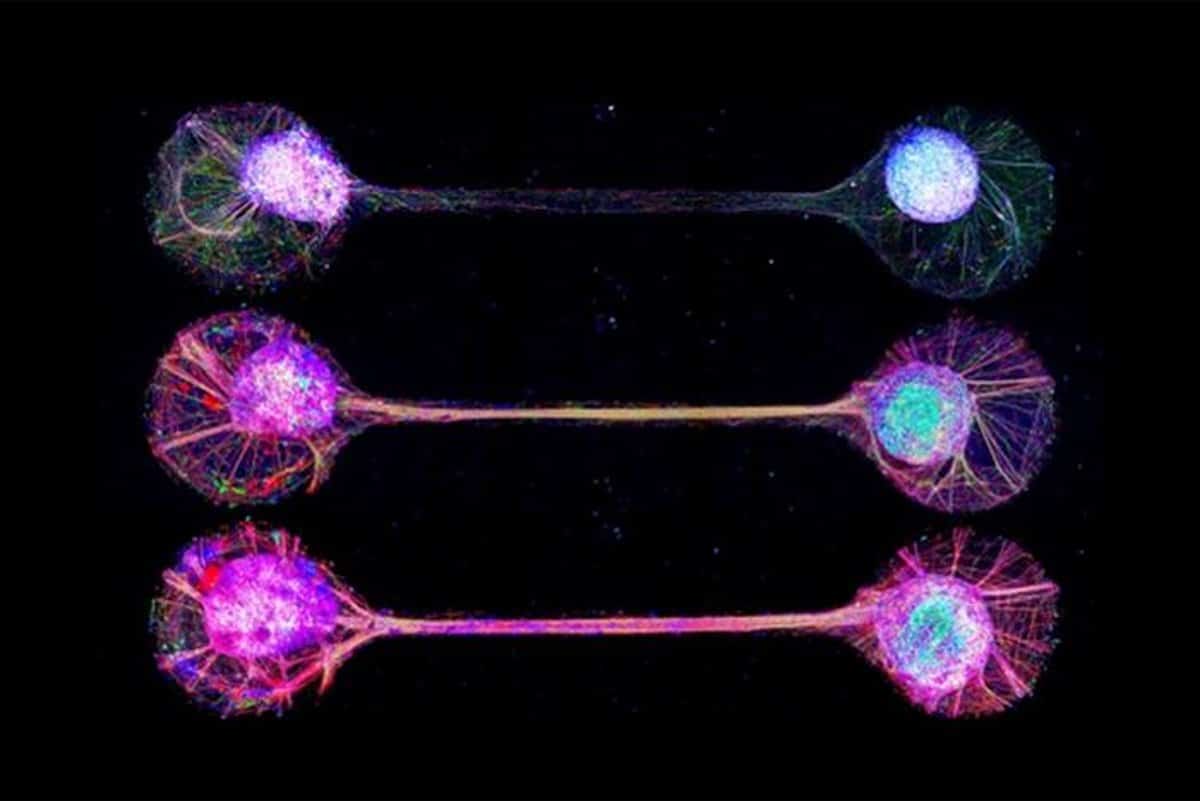Summary: Researchers successfully connected lab-grown brain tissues, mimicking the complex networks found in the human brain. This novel method involves linking “neural organoids” with axonal bundles, enabling the study of interregional brain connections and their role in human cognitive functions.
The connected organoids exhibited more sophisticated activity patterns, demonstrating both the generation and synchronization of electrical activity akin to natural brain functions. This breakthrough not only enhances our understanding of brain network development and plasticity but also opens new avenues for researching neurological and psychiatric disorders, offering hope for more effective treatments.
Key Facts:
- The research team linked neural organoids using axonal bundles, achieving more physiologically accurate connections that mirror those in the human brain.
- This connection method allowed for the observation of complex activity patterns and plasticity in the organoids, showing promise for studying brain functions and disorders.
- The study represents a significant step forward in creating functional brain-like tissues in the lab, providing a powerful tool for understanding human brain networks and their implications in health and disease.
Source: University of Tokyo
The idea of growing a functioning human brain-like tissues in a dish has always sounded pretty far-fetched, even to researchers in the field. Towards the future goal, a Japanese and French research team has developed a technique for connecting lab-grown brain-mimicking tissue in a way that resembles circuits in our brain.
It is challenging to study the exact mechanisms of brain development and functions. Animal studies are limited by differences between species in brain structure and function, and brain cells grown in the lab tend to lack the characteristic connections of cells in the human brain.

What’s more, researchers are increasingly realizing that these interregional connections, and the circuits that they create, are important for many of the brain functions that define us as humans.
Previous studies have tried to create brain circuits under laboratory conditions, which have been advancing the field.
Researchers from The University of Tokyo have recently found a way to create more physiological connections between lab-grown “neural organoids,” an experimental model tissue in which human stem cells are grown into three-dimensional developmental brain-mimicking structures.
The team did this by linking the organoids via axonal bundles, which is similar to how regions are connected in the living human brain.
“In single-neural organoids grown under laboratory conditions, the cells start to display relatively simple electrical activity,” says co-lead author of the study Tomoya Duenki.
“When we connected two neural organoids with axonal bundles, we were able to see how these bidirectional connections contributed to generating and synchronizing activity patterns between the organoids, showing some similarity to connections between two regions within the brain.”
The cerebral organoids that were connected with axonal bundles showed more complex activity than single organoids or those connected using previous techniques.
In addition, when the research team stimulated the axonal bundles using a technique known as optogenetics, the organoid activity was altered accordingly and the organoids were affected by these changes for some time, in a process known as plasticity.
“These findings suggest that axonal bundle connections are important for developing complex networks,” explains Yoshiho Ikeuchi, senior author of the study.
“Notably, complex brain networks are responsible for many profound functions, such as language, attention, and emotion.”
Given that alterations in brain networks have been associated with various neurological and psychiatric conditions, a better understanding of brain networks is important. The ability to study lab-grown human neural circuits will improve our knowledge of how these networks form and change over time in different situations, and may lead to improved treatments for these conditions.
About this neuroscience research news
Author: Yoshiho Ikeuchi
Source: University of Tokyo
Contact: Yoshiho Ikeuchi – University of Tokyo
Image: The image is credited to Institute of Industrial Science, The University of Tokyo
Original Research: Open access.
“Complex Activity and Short-Term Plasticity of Human Cerebral Organoids Reciprocally Connected with Axons” by Tomoya Duenki et al. Nature Communications
Abstract
Complex Activity and Short-Term Plasticity of Human Cerebral Organoids Reciprocally Connected with Axons
An inter-regional cortical tract is one of the most fundamental architectural motifs that integrates neural circuits to orchestrate and generate complex functions of the human brain.
To understand the mechanistic significance of inter-regional projections on development of neural circuits, we investigated an in vitro neural tissue model for inter-regional connections, in which two cerebral organoids are connected with a bundle of reciprocally extended axons.
The connected organoids produced more complex and intense oscillatory activity than conventional or directly fused cerebral organoids, suggesting the inter-organoid axonal connections enhance and support the complex network activity.
In addition, optogenetic stimulation of the inter-organoid axon bundles could entrain the activity of the organoids and induce robust short-term plasticity of the macroscopic circuit.
These results demonstrated that the projection axons could serve as a structural hub that boosts functionality of the organoid-circuits.
This model could contribute to further investigation on development and functions of macroscopic neuronal circuits in vitro.







